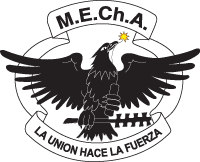
M.E.Ch.A. is a US-based organization that seeks to promote Chicano unity and empowerment through political action. The acronym of the organization's name is the Chicano word mecha, which is the Chicano pronunciation of the English word match and therefore symbolic of a fire or spark; mecha in Spanish means fuse or wick. The motto of MEChA is 'La Union Hace La Fuerza'.
The Plan Espiritual de Aztlán was a pro-indigenist manifesto advocating Chicano nationalism and self-determination for Mexican Americans. It was adopted by the First National Chicano Liberation Youth Conference, a March 1969 convention hosted by Rodolfo Gonzales's Crusade for Justice in Denver, Colorado.

The Brown Berets are a pro-Chicano organization that emerged in the late 1960s during the Chicano Movement. The group was co-founded by David Sanchez and Carlos Montes, and remains active today. The group was seen as part of the Third World Liberation Front. The Brown Berets' movements largely revolved around farmworkers' rights, educational reform, opposition to the Vietnam War, and organizing against police brutality. They have also sought to separate the American Southwest from the control of the U.S. government.
The Royal Chicano Air Force (RCAF) is a Sacramento, California-based art collective, founded in 1970 by Ricardo Favela, José Montoya and Esteban Villa. It was one of the "most important collective artist groups" in the Chicano art movement in California during the 1970s and the 1980s and continues to be influential into the 21st century.
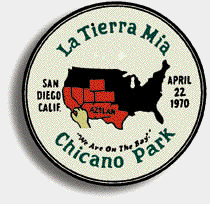
Chicano Park is a 32,000 square meter park located beneath the San Diego-Coronado Bridge in Barrio Logan, a predominantly Chicano or Mexican American and Mexican-migrant community in central San Diego, California. The park is home to the country's largest collection of outdoor murals, as well as various sculptures, earthworks, and an architectural piece dedicated to the cultural heritage of the community. Because of the magnitude and historical significance of the murals, the park was designated an official historic site by the San Diego Historical Site Board in 1980, and its murals were officially recognized as public art by the San Diego Public Advisory Board in 1987. The park was listed on the National Register of Historic Places in 2013 owing to its association with the Chicano Movement, and was designated a National Historic Landmark in 2016. Chicano Park, like Berkeley's People's Park, was the result of a militant people's land takeover. Every year on April 22, the community celebrates the anniversary of the park's takeover with a celebration called Chicano Park Day.
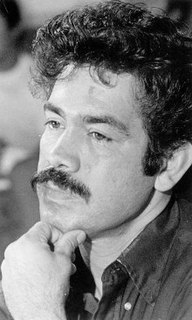
Rodolfo "Corky" Gonzales was a Mexican-American boxer, poet, political organizer, and activist. He was one of many leaders for the Crusade for Justice in Denver, Colorado. The Crusade for Justice was an urban rights and Chicano cultural urban movement during the 1960s focusing on social, political, and economic justice for Chicanos. Gonzales convened the first-ever Chicano Youth Liberation Conference in 1968, which was poorly attended due to timing and weather conditions. He tried again in March 1969, and established what is commonly known as the First Chicano Youth Liberation Conference. This conference was attended by many future Chicano activists and artists. It also birthed the Plan Espiritual de Aztlán, a pro-indigenist manifesto advocating revolutionary Chicano nationalism and self-determination for all Chicanos. Through the Crusade for Justice, Gonzales organized the Mexican American people of Denver to fight for their cultural, political, and economic rights, leaving his mark on history. He was honored with a Google Doodle in continued celebration of National Hispanic Heritage Month in the United States on 30 September 2021.
Chicanismo is the ideology behind the Chicano movement. It is an ideology based on a number of important factors that helped shape a social uprising in order to fight for the liberties of Mexican-Americans. Chicanismo was shaped by a number of intellectuals and influential activists as well as by the artistic and political sphere, and the many contributors to the ideology collaborated to create a strong sense of self-identity within the Chicano community. Cultural affirmation became one of the main methods of developing Chicanismo. This cultural affirmation was achieved by bringing a new sense of nationalism for Mexican-Americans, drawing ties to the long-forgotten history of Chicanos in lands that were very recently Mexican, and creating a symbolic connection to the ancestral ties of Mesoamerica and the Nahuatl language.
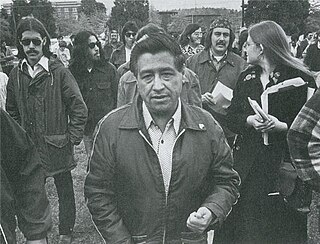
The Chicano Movement, also referred to as El Movimiento, was a social and political movement in the United States inspired by prior acts of resistance among people of Mexican descent, especially of Pachucos in the 1940s and 1950s, and the Black Power movement, that worked to embrace a Chicano/a identity and worldview that combated structural racism, encouraged cultural revitalization, and achieved community empowerment by rejecting assimilation. Before this, Chicano/a had been a term of derision, adopted by some Pachucos as an expression of defiance to Anglo-American society. With the rise of Chicanismo, Chicano/a became a reclaimed term in the 1960s and 1970s, used to express political autonomy, ethnic and cultural solidarity, and pride in being of Indigenous descent, diverging from the assimilationist Mexican-American identity. Chicanos also expressed solidarity and defined their culture through the development of Chicano art during El Movimiento, and stood firm in preserving their religion.

The Centro Cultural de la Raza is a non-profit organization with the specific mission to create, preserve, promote and educate about Chicano, Mexicano, Native American and Latino art and culture. It is located in Balboa Park in San Diego, California.The cultural center supports and encourages the creative expression “of the indigenous cultures of the Americas.” It is currently a member of the American Alliance of Museums.
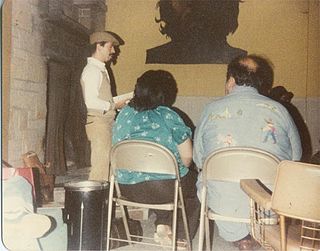
Alberto Baltazar Urista Heredia, better known by his nom de plume Alurista, is a Chicano poet and activist.
Las Adelitas de Aztlán was a short-lived Mexican American female civil rights organization that was created by Gloria Arellanes and Gracie and Hilda Reyes in 1970. Gloria Arellanes and Gracie and Hilda Reyes were all former members of the Brown Berets, another Mexican American Civil rights organization that had operated concurrently during the 1960s and 1970s in the California area. The founders left the Brown Berets due to enlarging gender discrepancies and disagreements that caused much alienation amongst their female members. The Las Adelitas De Aztlan advocated for Mexican-American Civil rights, better conditions for workers, protested police brutality and advocated for women's rights for the Latino community. The name of the organization was a tribute to Mexican female soldiers or soldaderas that fought during the Mexican Revolution of the early twentieth century.

The Ford Building, a Streamline Moderne structure in Balboa Park, San Diego, California, serves as the home of the San Diego Air & Space Museum. The building was built by the Ford Motor Company for the California Pacific International Exposition, which was held in 1935 and 1936. The Ford Motor Company build a total of five exposition buildings for the World's Fairs. This is the last remaining structure.
Salvador Roberto Torres is a Chicano artist and muralist and an early exponent of the Chicano art movement. He was one of the creators of Chicano Park, and led the movement to create its freeway-pillar murals. He was also a founder of the Centro Cultural de la Raza in San Diego, California.
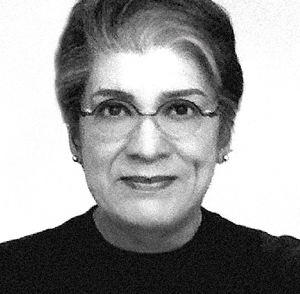
Judithe Hernández is an American artist and educator, she is known as a muralist, pastel artist, and painter. She a pioneer of the Chicano art movement and a former member of the art collective Los Four. She is based in Los Angeles, California and previously lived in Chicago.

The Chicano Art Movement represents groundbreaking movements by Mexican-American artists to establish a unique artistic identity in the United States. Much of the art and the artists creating Chicano Art were heavily influenced by Chicano Movement which began in the 1960s.

Precious Knowledge is a 2011 educational and political documentary that centers on the banning of the Mexican-American Studies (MAS) Program in the Tucson Unified School District of Arizona. The documentary was directed by Ari Luis Palos and produced by Eren Isabel McGinnis, the founders of Dos Vatos Productions.
Rafael Zamarripa Castañeda is a Mexican painter, sculptor, designer, dancer and choreographer
Victor Ochoa is an activist, painter, graphic designer and master muralist. He has painted over 100 murals, many of them in San Diego, California. He is considered one of the pioneers of San Diego's Chicano art movement. Ochoa was one of the original activists at Chicano Park and a co-founder of Centro Cultural de la Raza in Balboa Park, both in San Diego. He helped establish the influential Border Art Workshop/Taller de Arte Fronteriza (BAW/TAF). Ochoa is also a teacher of art and Chicano heritage. His work has been shown nationally and internationally, including at the Venice Bi-Annual, at the Museum of Contemporary Art, San Diego and in the groundbreaking exhibition, Chicano Art: Resistance and Affirmation (CARA). In addition to creating his own work, he is also a master of art preservation techniques, especially relating to murals. He is considered to be a "serious cultural resource in the border region.
Dorinda Moreno is an American Chicana activist, feminist and writer.
A Mexican American is a resident of the United States who is of Mexican descent. Mexican American-related topics include the following:











